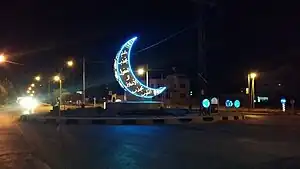Fanous
Fanous or Fanoos (Egyptian Arabic: فانوس IPA: [fæˈnuːs], pl. فوانيس [fæwæˈniːs]), also widely known as Fanous Ramadan (Arabic: فانوس رمضان),[1] is an Egyptian folk and traditional lantern used to decorate streets and homes in the month of Ramadan. With their origins in Egypt, they have since spread across the Muslim world and are a common symbol associated with the holy month.[2][3]
Etymology
The word "Fanous" (Fanos, Phanous and Fanoos in Egyptian dialects) is a term originating from Greek φανός, phanós. It means 'light' or 'lantern'. It was historically used in its meaning of "the light of the world," and is a symbol of hope, as in "light in the darkness".
History

The traditional use of fanous as decorations associated with Ramadan comes from Medieval Egypt,[4] where tradition holds the Egyptian people came out in masses while holding lanterns to welcome the Caliph Muizz while his arrival at Cairo during the holy month of Ramadan, as it was ancient tradition in Egypt to celebrate by lighting the streets with fanous lanterns. Its use has now spread to many Muslim countries.[5][3][6]


In Ancient times it was similar to a lamp, and would have incorporated either candles or oil. The fanous originally developed from the torches used in the Pharaonic festivals celebrating the rising of the star Sirius. For five days, the Ancient Egyptians celebrated the birthdays of Osiris, Horus, Isis, Seth and Nephtys—one on each day—by lighting the streets with the fanous (torches).[1] Torches or candles were also used in early Christianity. This is recorded by Egyptian historian Al-Maqrizi (1364 - 1442), who noted in his book, "Al Mawaiz wa al-'i'tibar bi dhikr al-khitat wa al-'athar", that these torches or candles were used at Christmastime for celebration.[3]
Use
Fanous is widely used all over the world – especially in Asian regions and the Arab world – not just for a specific religion purposes, but for names of people or decorative purposes. They can be found in houses, restaurants, hotels, malls, etc. Often arranged as a grouping of lights arranged in different designs and shapes. Metal and glass are mostly used for their construction.
References
- FanousArchived 2009-08-28 at the Wayback Machine; 2009 article; Al-Ahram Weekly Online
- "فانوس رمضان.. قصة بدأت فى "المحروسة".. استقبل به المصريون الخليفة المعز لدين الله الفاطمى.. وارتبط بالشهر الكريم.. واشتهرت صناعته من النحاس المنقوش وصولا للنسخ المقلدة والصناعة الصينى". Youm7.
- "The history of the fanous, Cairo's traditional Ramadan lantern". The National. 2022-04-01. Retrieved 2022-04-03.
- "The story behind Ramadan Lantern", DNE, 8 May 2018, retrieved 23 March 2023
- "فانوس رمضان.. قصة بدأت فى "المحروسة".. استقبل به المصريون الخليفة المعز لدين الله الفاطمى.. وارتبط بالشهر الكريم.. واشتهرت صناعته من النحاس المنقوش وصولا للنسخ المقلدة والصناعة الصينى". Youm7.
- "Folk: The Ramadan lantern - Street Smart - Folk". Ahram Online. Retrieved 2022-04-03.

